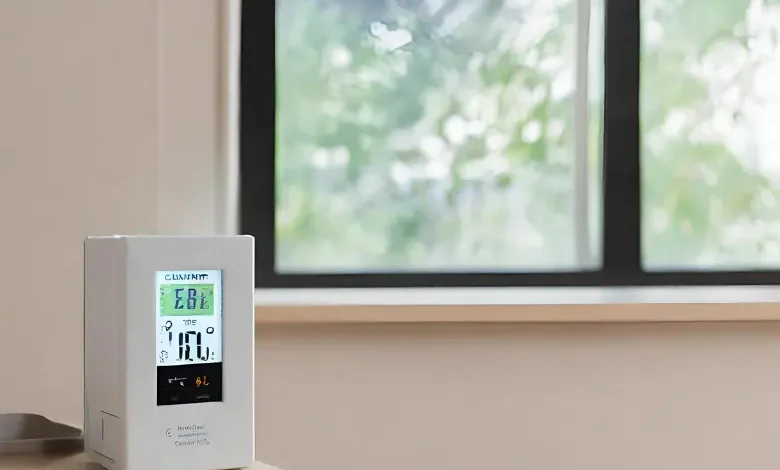The Symbiotic Dance: Exploring the Impact of Temperature Control on Indoor Air Quality

As our lives become increasingly intertwined with modern conveniences, the quest for a comfortable living environment extends beyond mere temperature control. The intricate relationship between temperature and indoor air quality (IAQ) plays a pivotal role in shaping the spaces we inhabit. In this comprehensive exploration, we will unravel the symbiotic dance between temperature control and indoor air quality, delving into the profound impact these elements have on our health, well-being, and overall living experience.
Also read: Best AC in India 2024
Impact of Temperature Control on Indoor Air Quality
1. Understanding Indoor Air Quality (IAQ)
Before delving into the intricacies of the relationship between temperature control and indoor air quality, it’s crucial to grasp the concept of IAQ. Indoor air quality refers to the cleanliness and health of the air within our living spaces. It encompasses various factors, including the concentration of pollutants, humidity levels, and the overall comfort of the indoor environment.
2. Temperature Control: More Than Just Comfort
2.1. Beyond Thermostats and Comfort Zones
While temperature control systems are commonly associated with maintaining comfort within a specified range, their impact transcends the realm of personal comfort. The temperature within a space significantly influences the concentration and behavior of airborne particles, pollutants, and microbial agents.
2.2. Temperature’s Influence on Airborne Contaminants
Temperature plays a crucial role in the dispersion, volatility, and behavior of airborne contaminants. In environments with inadequate temperature control, pollutants may linger, creating an environment conducive to the proliferation of allergens, mold, and other harmful particles. On the contrary, optimal temperature control can mitigate these risks, fostering a healthier indoor environment.
3. Humidity Management: The Silent Hero
3.1. Humidity’s Impact on IAQ
Humidity levels are intrinsically linked to both temperature and indoor air quality. Maintaining the right balance of humidity is essential for preventing the growth of mold, bacteria, and dust mites. High humidity can create an environment favorable to these pollutants, leading to respiratory issues and compromising overall IAQ.
3.2. Temperature’s Role in Mold Prevention
Temperature control is a key player in mold prevention. Mold thrives in damp and warm conditions, making effective temperature control a crucial strategy for minimizing mold growth. By keeping indoor spaces cool and dry, we create an inhospitable environment for mold and, consequently, enhance indoor air quality.
4. The Dynamic Dance: Temperature, Ventilation, and IAQ
4.1. Ventilation’s Impact on IAQ
Ventilation is an often-overlooked aspect of both temperature control and indoor air quality. Efficient ventilation systems ensure a continuous exchange of indoor and outdoor air, preventing the stagnation of pollutants. Properly controlled temperature, coupled with effective ventilation, promotes a constant flow of fresh air, reducing the concentration of contaminants.
4.2. Temperature’s Influence on Ventilation Efficiency
Temperature control significantly influences the efficiency of ventilation systems. In environments with extreme temperatures, ventilation systems may need to work harder to maintain the desired indoor climate. This increased workload can affect their effectiveness in circulating and purifying the air, ultimately impacting indoor air quality.
5. Effects on Respiratory Health
5.1. Temperature’s Role in Respiratory Comfort
The impact of temperature on respiratory health is undeniable. Extreme temperatures, whether too hot or too cold, can exacerbate respiratory conditions such as asthma and allergies. Maintaining a comfortable and controlled temperature not only enhances overall comfort but also alleviates respiratory stress.
5.2. Temperature, IAQ, and Respiratory Diseases
Temperature control is a critical factor in preventing the onset and progression of respiratory diseases. Poor IAQ, often associated with inadequate temperature control, has been linked to respiratory infections, exacerbation of asthma symptoms, and other respiratory issues. Therefore, a meticulous approach to temperature control becomes a proactive measure for preserving respiratory health.
6. Impact on Productivity and Cognitive Function
6.1. The Comfort-Productivity Nexus
Comfortable indoor temperatures have a direct impact on productivity and cognitive function. Extreme temperatures, whether too hot or too cold, can lead to discomfort, distraction, and a decline in cognitive performance. Efficient temperature control contributes to a conducive work environment, optimizing focus, and bolstering productivity.
6.2. Temperature Control and Cognitive Fatigue
In spaces where temperature control is neglected, occupants may experience cognitive fatigue—a phenomenon characterized by decreased alertness, impaired concentration, and reduced mental clarity. The interplay between temperature and indoor air quality is crucial in preventing cognitive fatigue and maintaining a vibrant and energizing atmosphere.
7. Smart Technologies: Shaping the Future of Comfort and IAQ
7.1. Integration for Optimal Performance
The integration of smart technologies in temperature control systems is revolutionizing the way we manage indoor air quality. Smart thermostats, equipped with sensors and learning capabilities, optimize temperature control based on usage patterns, occupancy, and outdoor conditions. This intelligent integration ensures not only comfort but also energy efficiency and enhanced IAQ.
7.2. Continuous Monitoring for IAQ Enhancement
Smart temperature control systems go beyond the conventional by incorporating continuous monitoring of indoor air quality. These systems can detect changes in pollutant levels, humidity, and ventilation effectiveness, allowing for real-time adjustments to optimize IAQ. The seamless integration of technology thus becomes a potent tool in maintaining a healthy and comfortable indoor environment.
Conclusion
In the intricate dance between temperature control and indoor air quality, the synergy is undeniable. Temperature influences the dispersion of pollutants, the growth of allergens, and the overall comfort of indoor spaces. As we navigate the challenges of creating sustainable, comfortable living environments, a holistic approach to temperature control—one that considers its impact on IAQ—emerges as a cornerstone of modern well-being. By understanding and embracing this symbiotic relationship, we pave the way for healthier, more comfortable, and more harmonious indoor spaces that nurture both body and mind.